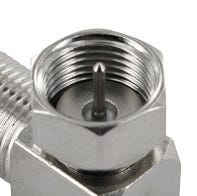One of the most common questions our Techs get asked about is which connector or lead they need to use to connect their Antenna to their television. It may seem like a simple question to those familiar with the process, but sometimes it’s those simple things that can confuse us. Today we wanted to give you an explanation of the parts required to complete the job.
A television antenna is designed to receive over-the-air broadcast television signals. The most popular and effective antenna is the “outdoor antenna” which is typically mounted on top of the roof using a long pole. A cable, often referred to as "RG6, Quad Shield or Coax” is connected to the antenna, and is usually fed through the roof, down the wall cavity and terminated at a wall plate. A "fly-lead" will then be connected from the wall plate to the back of your television or set top box.
Antenna plugs and sockets are devices that connect the TV set to the TV antenna (aerial).
Antenna plugs are male antenna connectors that fit into female antenna sockets.
Antenna sockets are female antenna connectors that have holes which accept the pins of antenna plugs inserted into them and deliver or receive TV signal to or from the plugs. Sockets are generally mounted on the TV set or in the wall as wall plates.
To start, you will need to identify the connection type on the back of your television/device and the antenna. Both male plugs and female sockets come as either F-type or PAL options. Some like to make their own leads using coaxial cable and the appropriate male or female connector, but it is usually easier to purchase a “ready-made” fly-lead with the connectors already attached.
Male PAL looks like this:

Female PAL connector looks like this:

The female PAL socket on the back of your television would look like this:

PAL Wallplate
Male F-Type looks like this:
Female F-Type connector looks like this:
The female F-Type socket typically found on a set top box or receiver would look like this:
F-Type Wallplate
At the other end of your coaxial lead you will need to connect your antenna.
Below is an example of an antenna which requires a Male F-Type connector.
Installing an antenna is not always straight forward, so if you’re not certain that you like the idea of getting up on your roof consider using a qualified installer to do it for you.
If you’re comfortable at DIY, check out our blog on mySwitch which is a great help in making sure your antenna is facing in the direction best suited for optimal signal strength.
Feel free to call and speak with our Selby Techs on 1800 69 2225 if you would like further information about antennas.














